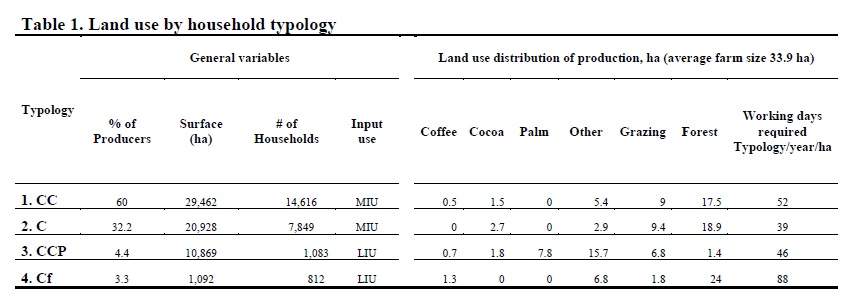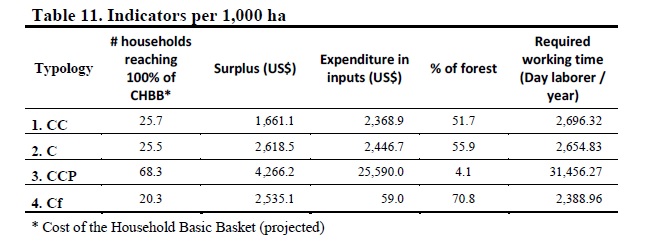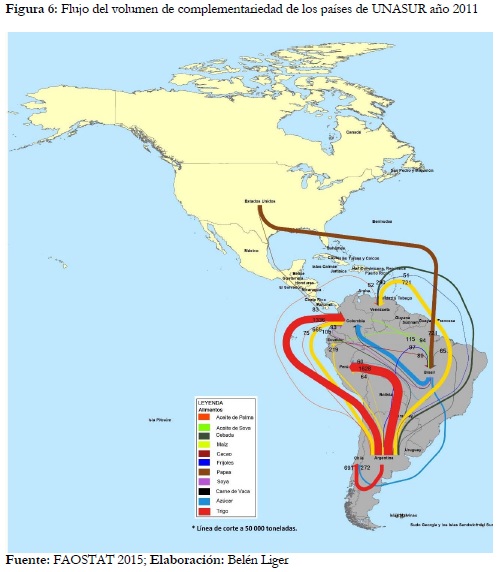Viteri Salazar, O., Ramos-Martin, J., Lomas, P.L. (2018): “Livelihood sustainability assessment of coffee and cocoa producers in the Amazon region of Ecuador using household types”, Journal of Rural Studies, Vol. 62: 1-9. https://doi.org/10.1016/j.jrurstud.2018.06.004
Free download until August 15, 2018: https://t.co/ZhyPNetmic

Abstract: Supporting small farmer livelihoods in fragile, biodiverse regions, such as tropical forests, is a priority for many development agencies and national governments. These regions tend to be characterized by recent human settlements, increasing populations and infrastructure development, as well as competitive land use activities, which exert pressure on fragile ecosystems. Improvement in livelihood strategies often focuses on increasing yields by improving productivity, but without taking into account alternative methods, such as better agricultural practices and their dependence on agrochemical inputs, changing land use through crop substitution, or improving product commercialization. In this research, we use household types, defined according to different land use patterns, in the Northern Amazon region of Ecuador to explore the limitations of, and identify future options for, improving livelihood strategies based on small-scale coffee and cocoa production. The results of the different types are discussed in order to highlight the methods’ utility and identify benefits in terms of environmental and social objectives versus economic profitability. Lessons are drawn that could be useful in applications of public policy aimed at the betterment of small coffee grower and cocoa farmer livelihood strategies, which involve thousands of families in the Amazon region of Ecuador, without compromising the environment.
Keywords: Household types, Amazon, Ecuador, Livelihoods, Coffee and cocoa, Sustainability
The main objective of this study is to contribute to the evaluation of agricultural production systems. This is done here by using a typology of four predominant production systems and comparing their performance against a set of indicators. A second objective is to inform decision makers about the differentiated outcomes these production systems have, so that tailored policy interventions can be designed based on the evaluation of past initiatives. In particular, this work focuses on: i) identifying the socioeconomic and environmental restrictions implicit in different land use patterns; ii) analysing how different land use patterns improve livelihoods in terms of income; and iii) identifying how certain public policies can lead to the establishment of particular types or lifestyles, thereby generating an impact on the income of small- scale producers.
After collecting the data, a typology of households was established as a method of conceptualization and empirical analysis. Household types have been largely used as societal functional units of analysis within integrated assessments for rural systems (Pastore et al., 1999; Giampietro, 2003; Scheidel et al., 2013; Williams et al., 2015), as well as often employed to strengthen the focus of policies and interventions associated with rural livelihoods (Gomiero and Giampietro, 2001; Niehof and Price, 2001; Senthilkumar et al., 2009; Serrano-Tovar and Giampietro, 2014; Tittonell et al., 2010; Williams et al., 2015).
The characterization of types was made in terms of land use patterns and impacts upon the environment, whether through the use of synthetic inputs, the implementation of monocultures or the expansion of the agricultural frontier and the consequent reduction in the forested area. The classification of typologies was based on the technical data sheets suggested by the National Institute of Agricultural Research (Instituto Nacional de Investigaciones Agropecuarias), in terms of area, level of agrochemical use, crop combination, etc., with consideration given to these recommendations as thresholds.
One characteristic shared by the different types is the need for crops that guarantee a permanent inflow of cash. In all cases, apart from coffee and cocoa, there are “other crops” (plantain, maize, cassava, rice and fruit trees) that help in providing food security to households. The types defined include farmers who share at least one of the cash crops, as follows: Type 1 contains coffee and cocoa plantations (CC); Type 2 contains only cocoa cultivation (C); Type 3 comprises coffee, cocoa and oil palm plantations (CCP); and finally, Type 4 only has coffee farming (Cf).

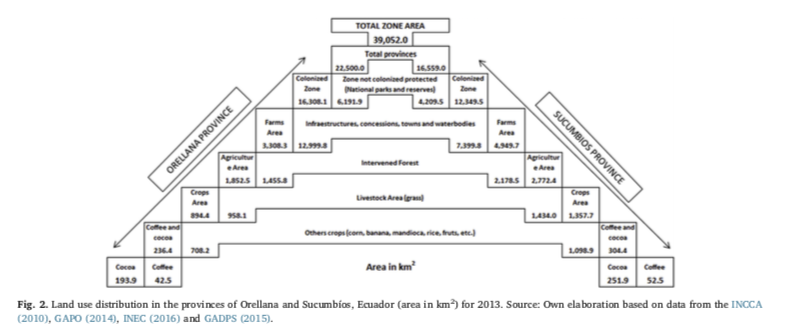
Income from coffee and cocoa production represents about 19% of total household income for Types 1 and 2 despite their low yield, whereas it is only 8% for Types 3 and 4. Type 3 earns more from other crops and oil palm, while Type 4 receives the most from off-farm work, although production at the farm still plays a cultural and environmental role.
Under these circumstances, Type 4 performs very well in environmental terms (LIU and 24 ha of forest) and is very close to Type 2 in economic terms. Hence, there is a need to increase income via improving some agricultural practices (e.g., pruning), selecting plants and particularly changing to commercialization, thus making it possible for smallholders to move up the value chain. Unless measures supporting productive activity of this type are implemented, a shift towards Types 1 and 2 could be expected, or even worse towards Type 3 by means of selling or renting their land.
The analysis of the surplus generated by each type helps in identifying the reasons why households have chosen different productive patterns. It can be seen how cocoa has gradually replaced the cultivation of coffee. According to the Third National Agricultural Census (2000), 49,389 ha of coffee and 7751 ha of cocoa were present in the area, while, according to our study, there were 44,580 ha of cocoa and 9500 ha of coffee in 2013 (Fig. 2). This is consistent with our results, as Type 2 has a higher surplus than Type 1, which has the lowest surplus of all and depends largely on off-farm work for guaranteeing livelihood. Until 10 years ago, large-scale landowners dominated oil palm plantations. Only recently have smallholders engaged in oil palm production, thus giving rise to Type 3. Despite the fact that plantations are still young (four to eight years), they already show the highest surplus (US $144.63); however, from an environmental point of view, they are the least interesting of all, because they involve a HIU, with forest only covering 4% of land, and the number of families that have benefited from that is very low (4.5%). One can understand why private enterprises and even the central government are interested in this type (profits, but also greater GDP and taxes). However, this type also re- presents more environmental impacts and a greater degree of dependency for the households (a large fraction of their income is ex- pended in buying agrochemicals from the very same intermediaries who are commercializing palm oil). These reasons do not make this type, in our view, an option for future development.
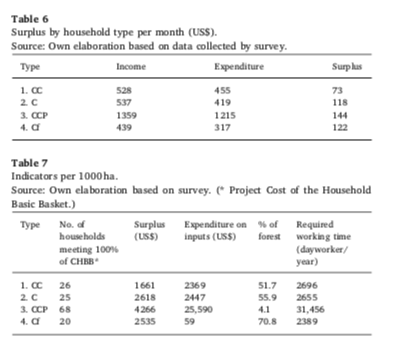
Creating types for an analytical case study in one of the most important areas of the Ecuadorian Amazon, with highly biodiverse ecosystems and significant forest cover, allows for visualizing different land use patterns linked to economic resource generation as a means of subsistence. This behaviour is strongly linked to public policies being developed in the sector, where it is believed that oil palm monocultures could be a better alternative revenue source for farmers. However, as shown in Types 2 and 4, its utility is very similar to Type 3 (oil palm), but with a much lower dependence on intensive agrochemical use in the case of Type 2 and a practically null value in Type 4, which hardly uses agrochemical inputs. The differentiated performance of types should encourage the design of tailored interventions to address the problems encountered by each of them, promoting those types with less environmental impact, but which still provide the necessary means for livelihoods and incentives for the conversion of the types with more impact.
The intensity of land use, marked in large part by the expansion of the agricultural frontier and the reduction in forest cover on farms, is much lower in Type 4 than in the other types, making this form of production more desirable in environmental terms. However, this type shows a limitation in terms of income generation, as nearly 35% of its income comes from off-farm work performed by dayworkers. This aspect is important to consider in the development of agricultural programmes oriented toward jump-starting production, where time dedicated by farmers is an important variable, since this type would not have any time restrictions when either adopting a more labour-intensive agricultural practice or expanding the agricultural frontier. In contrast, Type 4 reflects the practical impossibility of adding crops to a farm, since agricultural use of the available land surface is found to be at 96% capacity.
Identifying the land use and economic income corresponding to types has also revealed the fact that Type 2 represents the lowest labour demand per hectare, an aspect that could be useful for pushing programmes focused on cocoa production, in which labour availability, on the one hand, and profitability per hectare for cocoa and coffee, on the other, should be analysed.
